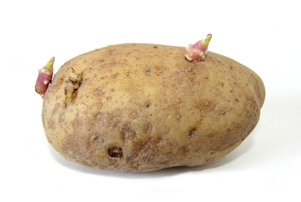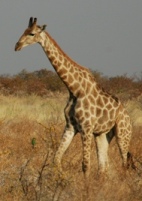Classification

Domain: Eukarya
Kingdom: Plantae
Phylum: Magnoliophyta
Class: Magnoliopsida
Order: Solanales
Family: Solonaceae
Genus: Atropa
Species: Atropa belladonna
© Karelj 2011
Domain: Eukarya
Deadly Nightshade belongs in this domain because it possesses
a true nucleus and membrane bound organelles. Eukarya is a very
broad classification, including organisms ranging from
giraffes to
slime molds to
pineapple.
© Patrick Giraud
2006
Kingdom: Plantae
Deadly Nightshade falls under Plantae because
organisms in this kingdom have chloroplasts and cell walls
composed primarily of cellulose. They are mostly autotrophic,
and the majority of them exhibit an alternation of generations.
Some other organisms in this kingdom are
white willow,
mango trees, and
wild rice.
© Kglavin 2005
Phylum: Magnoliophyta
This phylum is also known as the Angiosperms, or
flowering plants. It can also be referred to as Anthophyta,
which is then divided into classes different from those of Magnoliophyta. Deadly
 Nightshade can be put into this
phylum, because it has vascular tissue and reproduces via seeds,
which are formed through pollination. Another organism in this
phylum is the
passion fruit tree.
Nightshade can be put into this
phylum, because it has vascular tissue and reproduces via seeds,
which are formed through pollination. Another organism in this
phylum is the
passion fruit tree.
© yo 2007
Class: Magnoliopsida
This class is also known as the Dicots. (If I had
classified Atropa belladonna under Anthophyta instead of
Magnoliophyta, I would use the class Dicotyledonae. However, the
characteristics of the two different classes are the same.) Its
defining characteristics are leaves with netted veins, and floral
reproductive organs occurring in multiples of either four or five.
They are also characterized by their taproot, instead of the fibrous
root system that Monocots possess. Their seeds have two cotyledons,
which become the first leaves of the plant when it gets exposed to
sunlight, and their pollen grains have three pores instead of the
one that Monocots have. Some examples of other plants in this class
are
apple trees,
rye, and
licorice.
Order: Solanales
There's not much to say about this order, other
than the fact that it contains seven families. One of these families
is Solonaceae, from which this order takes its name. It is a part of
the subclass Asteridae, which is characterized by being sympetalous
(the petals are partially or completely fused together). All of the
members of this order are dicotyledonous flowering plants.
 Family: Solonaceae
Family: Solonaceae
Deadly Nightshade is a part of the potato family,
also known as the nightshade family. The majority of plants in this
family have perfect flowers (both sexes are present in the same
flower), and alternating leaves. The potato family includes popular
crops such as
potatoes (there's a shocker), tomatoes, eggplant, and various
types of peppers, including
chili peppers.
Genus: Atropa
Fun fact for you: This genus is named after one of
the Three Fates in Greek mythology, Atropos, the one that cut the
thread of life. This genus contains five species: A. acuminata,
A. baetica, A. belladonna, A. caucasica, and A. pallidiflora.
Species: Atropa belladonna
The word "belladonna" means "beautiful lady," and refers to the
old Italian practice of women putting the sap of Deadly Nightshade
in their eyes to dilate their pupils, apparently making them appear
more beautiful. I would definitely not recommend doing this, seeing
as the plant contains many unsafe toxins. If you're really set on
dilating your pupils, I'm sure you could go talk to an
optometrist.
© H. Zell 2009
Phylogenies
Tree composed from BIO 203
lecture material.
 All
plants fall under the supergroup Archaeplastida, a group
characterized mainly by its secondary endosymbiosis of
cyanobacteria. Those intimidatingly long words basically mean that
the common ancestor of the organisms in this group engulfed
cyanobacteria at one time, making the bacteria a part of themselves.
Over time, the cyanobacteria evolved into the chloroplasts that
allow the organisms of the Archaeplastida supergroup to
photosynthesize.
All
plants fall under the supergroup Archaeplastida, a group
characterized mainly by its secondary endosymbiosis of
cyanobacteria. Those intimidatingly long words basically mean that
the common ancestor of the organisms in this group engulfed
cyanobacteria at one time, making the bacteria a part of themselves.
Over time, the cyanobacteria evolved into the chloroplasts that
allow the organisms of the Archaeplastida supergroup to
photosynthesize.
Phylogenetic tree composed from BIO 203 lecture materials.
 In
the Plantae kingdom, there are seven major divisions. These phyla
are grouped based on the presence or absence of vascular tissue, the
presence or absence of seeds, and the dominance of either the
sporophyte or gametophyte generation.
In
the Plantae kingdom, there are seven major divisions. These phyla
are grouped based on the presence or absence of vascular tissue, the
presence or absence of seeds, and the dominance of either the
sporophyte or gametophyte generation.
The Liverworts, Hornworts, and true mosses do not have seeds - instead they reproduce via spores. These phyla also do not have vascular tissue, which limits the height and width they can grow to. As a result, their gametophyte generations are dominant.
Moving down the phylogenetic tree, the Lycophytes and Pterophytes have vascular tissue, meaning they can grow taller, but they still reproduce via spores instead of seeds. Their gametophyte and sporophyte generations are equally dominant.
Angiosperms and Gymnosperms have vascular tissue, reproduce via seeds, and have a dominant sporophyte generation. Atropa belladonna falls under the Angiosperm division, meaning it has flowers and its seeds are protected, not "naked" like the seeds of Gymnosperms.
Click here to read about
the Habitat of Atropa belladonna,
or here to go back to the Home page.

